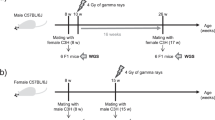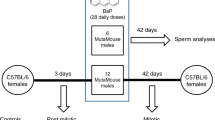Abstract
Ionizing radiations are known to induce tumors, chromosomal lesions and minisatellite length variations, yet no correlation has been demonstrated between radiation exposure and indels or copy number polymorphism (CNP) of the genes. We studied the impact of natural background radiation (NBR) on the human Y chromosome owing to its haploid status and clonal inheritance. We analyzed the AZFc region using the DNA from blood and semen of 100 males living near the coastal peninsula in Kerala (India), exposed to NBR along with other 50 normal fertile males. STS mapping of AZFc region showed random microdeletions without conclusive gr/gr or b1/b3 phenotypes. Using a highly specific novel Taqman assay based on sY587 sequence, we detected four copies of the DAZ genes in normal males and 4–16 in those exposed to NBR. Amongst NBR exposed males with multiples copies of the DAZ genes, 75% showed varying FISH signals for DAZ genes with cosmid 18E8 whereas 30% showed mosaicism in terms of presence/absence of the signals in 6–8% cells and unexpected number of signals in 9–12% interphase nuclei. Startlingly, all germline samples studied were found to be free from AZFc microdeletions and CNP of the DAZ genes. Since the DAZ genes are heavily implicated with the germ cell development, the cells with DAZ deletion/duplication are unlikely to survive. Alternatively, an innate mechanism may be operative to protect the germline from the effects of NBR.







Similar content being viewed by others
References
Ali S, Muller CR, Epplen JT (1986) DNA fingerprinting by oligonucleotides probes specific for simple repeats. Hum Genet 74:239–243
Bashamboo A, Rahman MM, Prasad A, Sebastian PC, Ahmad J, Ali S (2005) Fate of SRY, PABY, DYS1, DYZ3 and DYZ1 loci in Indian patients harbouring sex chromosome anomalies. Mol Hum Reprod 11:117–127
Dickinson HO, Parker L (2002) Leukemia and non-Hodgkin’s lymphoma in children of Sellafield male radiation workers. Int J Cancer 99:437–444
Dubrova YE, Grant G, Chumak AA, Stejhka VA, Karakasian AN (2002) Elevated minisatellite mutation rate in the post-Chernobyl families from Ukraine. Am J Hum Genet 71:801–809
Ferlin A, Moro E, Rossi A, Foresta C (1999) Human male infertility and Y chromosome deletions: role of AZF-candidate genes DAZ, RBM, and DFFRY. Hum Reprod 14:1710–1716
Ferlin A, Moro E, Rossi A, Foresta C (2002) A novel approach for the analysis of DAZ gene copy number in severely idiopathic infertile men. J Endocrinol Invest 25:RC1–RC3
Fernandes S, Huellen K, Goncalves J, Dukal H, Zeisler J, Rajpert De Meyts E, Skakkebaek NE, Habermann B, Krause W, Sousa M, Barros A, Vogt PH (2002) High frequency of DAZ1/DAZ2 gene deletions in patients with severe oligospermia. Mol Hum Reprod 8:286–298
Fernandes S, Parachchini S, Meyer LH, Florida G, Tyler-Smith C, Vogt PH (2004) A large AZFc deletion removes DAZ3/DAZ4 and nearby genes from men in Y haplogroup N. Am J Hum Genet 74:180–187
Force A, Lynch M, Pickett FB, Amores A, Yan Y-L (1999) Preservation of duplicate genes by complementary, degenerative mutations. Genetics 151:1531–1545
Forster L, Forster P, Lutz-bonengel S, Wilkomm H, Brinkmann B (2002) Natural radioactivity and human mitochondrial DNA mutations. Proc Natl Acad Sci 99:13950–13954
Glacer B, Hierl T, Taylor K, Schiebel K, Zeitler S (1997) High resolution fluorescence in situ hybridization of human Y linked genes on released chromatin. Chromosome Res 5:23–30
Glacer B, Yen PH, Schempp W (1998) Fiber fluorescence in situ hybridization unravels apparently seven DAZ genes or pseudo genes clustered within a Y chromosome region frequently deleted in azoospermic males. Chromosome Res 6:481–486
Hande MP, Azizova TV, Geard RC, Burak LE, Mitchell CR (2003) Past exposure to densely ionizing radiation leaves a unique permanent signature in the genome. Am J Hum Genet 72:1162–1170
He X, Zhang J (2005) Gene complexity and gene duplicability. Curr Biol 15:1016–1021
Hoof V (2005) Conserved functions of yeast genes support the duplication, degeneration and complementation model for gene duplication. Genetics 171:1455–1461
Kuroda-Kawaguchi T, Skaletsky H, Brown LG, Minx PJ, Cordum HS, Waterson RH, Wilson RK, Silber S, Oates R, Rozen S, Page DC (2001) The AZFc region of the Y chromosome features massive palindromes and uniform recurrent deletions in infertile men. Nat Genet 29:279–286
Loucas BD, Eberle RL, Durante M, Cornforth MN (2004) Complex chromatid-isochromatid exchanges following irradiation with heavy ions? Cytogenet Genome Res 104:206–210
Mestres M, Cabllin MR, Schmid E, Stephan G, Sachs R, Barrios L, Barquinero JF (2004) Analysis of alpha-particle induced chromosome aberrations in human lymphocytes, using pan-centromeric and pan-telomeric probes. Int J Radiat Biol 80:737–744
Ohno S (1999) Gene duplication and the uniqueness of vertebrate genomes circa 1970–1999. Semin Cell Dev Biol 10:517–522
Plumb BR, Boulton F, Roux I, Dubrova YE (2002) Elevated mutation rates in the germ line of first and second generation offspring of irradiated male mice. Proc Natl Acad Sci 99:6877–6882
Premi S, Srivastava J, Sebastian PC, Ahmad J, Ali S (2006) Tandem duplication and copy number polymorphism of the SRY gene in patients with sex chromosome related anomalies and males exposed to natural background radiation. Mol Hum Reprod 12:113–121
Prise KM, Pinto M, Newman HC, Michael BD (2001) A review of studies of ionizing radiation-induced double stranded break clustering. Radiat Res 156:572–576
Reijo R, Lee TY, Salo P, Alagappan R, Brown LG, Rosenberg M, Rozen S, Jaffe T, Strauss D, Hovatta O, de la Chapelle A et al (1995) Diverse spermatogenic defects in humans caused by Y chromosome deletions encompassing a novel RNA binding protein genes. Nat Genet 10:383–393
Reijo R, Algappan RK, Patrizio P, Page DC (1996) Severe oligozoospermia resulting from deletion of azoospermia factor gene on Y chromosome. Lancet 347:1290–1293
Repping S, Skaletsky H, Brown L, van Daalen SK, Korver CM, Pyntikova T, Kuroda-Kawaguchi T, de Vries JWA, Oates RD, Silber S, van der Veen F et al (2003) Polymorphism for a 1.6-Mb deletion of the human Y chromosome persists through balance between recurrent mutation and haploid selection. Nat Genet 35:247–251
Rydberg B (2001) Radiation-induced DNA damage and chromatin structure. Acta Oncol 40(6):682–685
Saxena R, Brown LG, Hawkins T, Algappan RK, Skaletsky H (1996) The DAZ gene cluster on human Y chromosome arose from an autosomal gene was transposed, repeatedly amplified and pruned. Nat Genet 14:292–299
Saxena R, De Vries JWA, Repping S, Algappan R, Skaletsky H (2000) Four DAZ genes in two clusters found in AZFc region of the human Y chromosome. Genomics 67:256–267
Sebat J, Lakshmi B, Troge J, Alexander J, Young J, Lundin P, Maner S, Massa H, Walker M, Chi M, Navin N et al (2004) Large scale copy number polymorphism in the human genome. Science 305:525–528
Writzl K, Zorn B, Peterlin B (2005) Copy number of DAZ genes in infertile men. Fertil Steril 84:1522–1525
Yen PH (1998) A long range restriction map of deletion interval o6 of the human Y chromosome: a region frequently deleted in azoospermic males. Genomics 54:5–12
Acknowledgments
This work was supported by a DBT Grants No. BT/PR2255/Med/13/077/2000 and BT/PR2752/AAQ/01/113/2001 to S.A. and a core grant from the Department of Biotechnology, Government of India to the National Institute of Immunology, New Delhi. The equipment donation from the Alexander Von Humboldt Foundation, Bonn, Germany is gratefully acknowledged. We thank Dr. Sangeeta Thatai and Shri Khem Singh Negi for technical assistance.
Author information
Authors and Affiliations
Corresponding author
Rights and permissions
About this article
Cite this article
Premi, S., Srivastava, J., Chandy, S.P. et al. AZFc somatic microdeletions and copy number polymorphism of the DAZ genes in human males exposed to natural background radiation. Hum Genet 121, 337–346 (2007). https://doi.org/10.1007/s00439-006-0318-7
Received:
Accepted:
Published:
Issue Date:
DOI: https://doi.org/10.1007/s00439-006-0318-7




